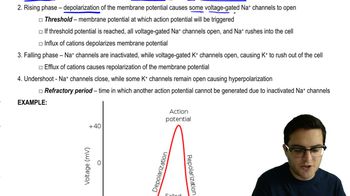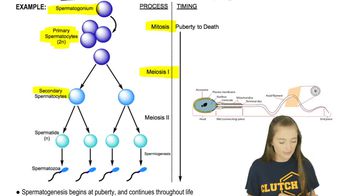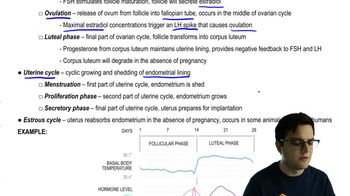- 1. Introduction to Biology2h 40m
- 2. Chemistry3h 40m
- 3. Water1h 26m
- 4. Biomolecules2h 23m
- 5. Cell Components2h 26m
- 6. The Membrane2h 31m
- 7. Energy and Metabolism2h 0m
- 8. Respiration2h 40m
- 9. Photosynthesis2h 49m
- 10. Cell Signaling59m
- 11. Cell Division2h 47m
- 12. Meiosis2h 0m
- 13. Mendelian Genetics4h 41m
- Introduction to Mendel's Experiments7m
- Genotype vs. Phenotype17m
- Punnett Squares13m
- Mendel's Experiments26m
- Mendel's Laws18m
- Monohybrid Crosses16m
- Test Crosses14m
- Dihybrid Crosses20m
- Punnett Square Probability26m
- Incomplete Dominance vs. Codominance20m
- Epistasis7m
- Non-Mendelian Genetics12m
- Pedigrees6m
- Autosomal Inheritance21m
- Sex-Linked Inheritance43m
- X-Inactivation9m
- 14. DNA Synthesis2h 27m
- 15. Gene Expression3h 20m
- 16. Regulation of Expression3h 31m
- Introduction to Regulation of Gene Expression13m
- Prokaryotic Gene Regulation via Operons27m
- The Lac Operon21m
- Glucose's Impact on Lac Operon25m
- The Trp Operon20m
- Review of the Lac Operon & Trp Operon11m
- Introduction to Eukaryotic Gene Regulation9m
- Eukaryotic Chromatin Modifications16m
- Eukaryotic Transcriptional Control22m
- Eukaryotic Post-Transcriptional Regulation28m
- Eukaryotic Post-Translational Regulation13m
- 17. Viruses37m
- 18. Biotechnology2h 58m
- 19. Genomics17m
- 20. Development1h 5m
- 21. Evolution3h 1m
- 22. Evolution of Populations3h 52m
- 23. Speciation1h 37m
- 24. History of Life on Earth2h 6m
- 25. Phylogeny2h 31m
- 26. Prokaryotes4h 59m
- 27. Protists1h 12m
- 28. Plants1h 22m
- 29. Fungi36m
- 30. Overview of Animals34m
- 31. Invertebrates1h 2m
- 32. Vertebrates50m
- 33. Plant Anatomy1h 3m
- 34. Vascular Plant Transport2m
- 35. Soil37m
- 36. Plant Reproduction47m
- 37. Plant Sensation and Response1h 9m
- 38. Animal Form and Function1h 19m
- 39. Digestive System10m
- 40. Circulatory System1h 57m
- 41. Immune System1h 12m
- 42. Osmoregulation and Excretion50m
- 43. Endocrine System4m
- 44. Animal Reproduction2m
- 45. Nervous System55m
- 46. Sensory Systems46m
- 47. Muscle Systems23m
- 48. Ecology3h 11m
- Introduction to Ecology20m
- Biogeography14m
- Earth's Climate Patterns50m
- Introduction to Terrestrial Biomes10m
- Terrestrial Biomes: Near Equator13m
- Terrestrial Biomes: Temperate Regions10m
- Terrestrial Biomes: Northern Regions15m
- Introduction to Aquatic Biomes27m
- Freshwater Aquatic Biomes14m
- Marine Aquatic Biomes13m
- 49. Animal Behavior28m
- 50. Population Ecology3h 41m
- Introduction to Population Ecology28m
- Population Sampling Methods23m
- Life History12m
- Population Demography17m
- Factors Limiting Population Growth14m
- Introduction to Population Growth Models22m
- Linear Population Growth6m
- Exponential Population Growth29m
- Logistic Population Growth32m
- r/K Selection10m
- The Human Population22m
- 51. Community Ecology2h 46m
- Introduction to Community Ecology2m
- Introduction to Community Interactions9m
- Community Interactions: Competition (-/-)38m
- Community Interactions: Exploitation (+/-)23m
- Community Interactions: Mutualism (+/+) & Commensalism (+/0)9m
- Community Structure35m
- Community Dynamics26m
- Geographic Impact on Communities21m
- 52. Ecosystems2h 36m
- 53. Conservation Biology24m
44. Animal Reproduction
Animal Reproduction
Problem 16
Textbook Question
In the 1960s, the U.S. Food and Drug Administration approved a contraceptive that allowed women to plan desired pregnancies and prevent unwanted pregnancies. Oral hormonal contraception ('the pill') uses synthetic hormones similar in structure to progesterone and/or estradiol. What is the pill's mechanism of action? Imagine that four different contraceptives are under development. One blocks ovulation, one blocks fertilization, one blocks cleavage, and one blocks implantation. In the United States, which contraceptive is likely to be the least controversial to bring to market? Why?
 Verified step by step guidance
Verified step by step guidance1
Understand the mechanism of action of oral hormonal contraception: Oral contraceptives primarily work by releasing synthetic hormones similar to progesterone and estradiol. These hormones prevent ovulation, the release of eggs from the ovaries, which is essential for pregnancy to occur. By stopping ovulation, the pill effectively prevents sperm from having an egg to fertilize.
Identify the mechanisms of the four contraceptives under development: (1) One that blocks ovulation prevents the release of eggs from the ovaries. (2) One that blocks fertilization prevents sperm from meeting and fertilizing an egg. (3) One that blocks cleavage prevents the early division of a fertilized egg. (4) One that blocks implantation prevents a fertilized egg from attaching to the uterus wall.
Consider the ethical and societal implications: In the United States, contraceptives that act before fertilization (blocking ovulation or fertilization) are generally less controversial than those acting after fertilization (blocking cleavage or implantation). This is because many ethical debates center around the definition of when life begins, with some viewpoints considering life to begin at fertilization.
Determine the least controversial contraceptive: Based on societal and ethical considerations, the contraceptive that blocks ovulation is likely to be the least controversial. This method prevents the formation of a fertilizable egg, thus avoiding the ethical concerns associated with fertilization and potential life.
Explain why blocking ovulation is less controversial: Since this method prevents the egg from being released, it ensures that fertilization cannot occur. This aligns more closely with widely accepted preventive methods and avoids the contentious issues surrounding the status of a fertilized egg.
Recommended similar problem, with video answer:
 Verified Solution
Verified SolutionThis video solution was recommended by our tutors as helpful for the problem above
Video duration:
1mPlay a video:
Was this helpful?
Key Concepts
Here are the essential concepts you must grasp in order to answer the question correctly.
Mechanism of Action of Oral Contraceptives
Oral hormonal contraceptives, commonly known as 'the pill', primarily work by inhibiting ovulation. They achieve this by delivering synthetic hormones, such as estrogen and progesterone, which prevent the release of eggs from the ovaries. Additionally, these hormones thicken cervical mucus, making it more difficult for sperm to enter the uterus, and alter the uterine lining to prevent implantation of a fertilized egg.
Recommended video:
Guided course

Action Potential
Types of Contraceptive Mechanisms
Contraceptives can function through various mechanisms: blocking ovulation prevents the release of eggs; blocking fertilization stops sperm from reaching the egg; blocking cleavage inhibits the division of the fertilized egg; and blocking implantation prevents a fertilized egg from attaching to the uterine wall. Understanding these mechanisms is crucial for evaluating the potential effectiveness and ethical considerations of different contraceptive methods.
Recommended video:
Guided course

Types of Phosphorylation
Controversy Surrounding Contraceptives
The controversy surrounding contraceptives often hinges on their mechanisms of action and perceived moral implications. In the U.S., contraceptives that prevent ovulation or fertilization are generally less controversial, as they do not involve the termination of a potential pregnancy. In contrast, methods that block implantation or cleavage may face more ethical scrutiny, as they can be viewed as interfering with a fertilized egg's development, leading to debates about when life begins.
Recommended video:
Guided course

Thermodynamics: System vs. Surroundings

 5:44m
5:44mWatch next
Master Sexual and Asexual Reproduction with a bite sized video explanation from Jason Amores Sumpter
Start learningRelated Videos
Related Practice



































































